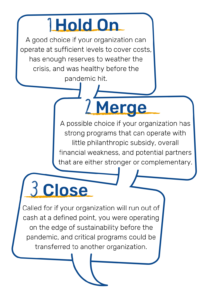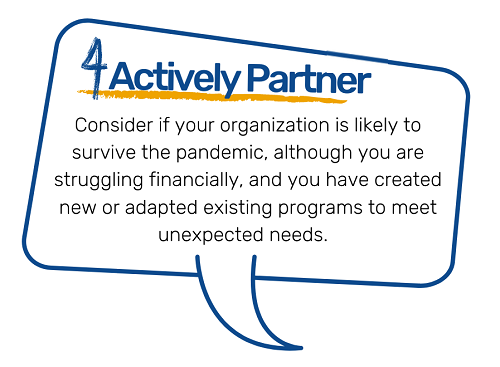Active Partnership: A Sound Strategic Choice
Strategic Decisions During a Crisis Blog Series
La Piana Consulting’s recent Sector Impact Survey of nonprofits confirmed the devastating effects of the COVID-19 pandemic on the sector. In response, David La Piana has described three basic strategic choices nonprofits can make in this moment:

I would like to offer a fourth, hybrid of the first two options – actively partner.

Nonprofits that are likely to survive but are struggling may find new efficiencies by creating joint programs or sharing back office services with another organization. This option entails actively thinking, moving, and changing to take advantage of the moment versus biding time until the pandemic passes.
To make this option work, first be clear about your organization’s key strengths and the role you play in the field. Next, think about peer organizations and where their strengths lie. Active partnerships work best when one organization is either stronger or complementary in a given area, and is especially compelling if your two organizations are engaged in duplicative work (even if the way you carry out that work is different).
For example, La Piana Consulting worked with one nonprofit that serves families through a broad array of programs including adoption, aging services, counseling, and refugee and immigrant support. With the pandemic’s onset, the organization’s clients suddenly lacked access to food, due to a combination of inaccessibility and loss of income. The nonprofit immediately launched a food delivery service to ensure continuity of service. Although this new service was the right response to meet client needs in the moment, leadership understands that this activity falls outside the range of their core competencies. Thus, the organization is in the process of identifying a partner to maintain the service, one that is focused on addressing food insecurity and that has the infrastructure to operate the program on an ongoing basis and mechanisms to provide the service safely.
A second example to illustrate my point: many nonprofits have created resource guides for staff to help clients navigate rapidly changing, unexpected needs due to COVID-19. The initial work of compiling such a resource can be a relatively simple but ensuring thoroughness and maintaining its accuracy is not (think key contact information, service availability, changes in operating hours, etc.). Since 2-1-1 systems exist in most areas throughout the U.S. and are already designed to create and maintain referral guides, your organization could establish a partnership with your local 2-1-1 provider to develop a customized guide relevant to the needs of your particular clients. This solution is especially well-suited for nonprofits that serve specific communities like seniors, youth, immigrants, different language groups, or other identifiable populations.
La Piana specializes in guiding organizations through the partnership exploration process, from informal collaborations to merger, and the many options in between. We help clients negotiate program design, governance, fundraising responsibilities, sustainability commitments, and implementation plans to improve mission impact while reducing overall cost.
Have you considered actively partnering with others? If not, what’s holding you back? Please comment below.


Comment section